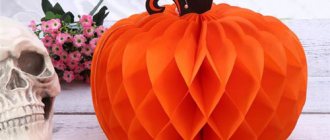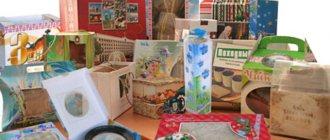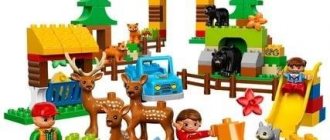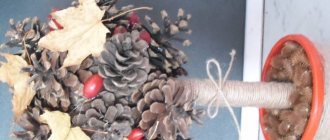Cutting templates
Using templates greatly simplifies your work. Each part can be reused multiple times. The templates are provided ready-made, you just need to download and print. If the desired object is not available, then you should use a photo or picture. It is enough to transfer the schematic image onto paper, edit it, and cut it out. Then put it on a sheet of paper, copy and cut it out. For those who love design, creating your own models is more suitable. The advantage of templates is the possibility of repeated use and repeated creation of identical layouts.
Photo examples with diagrams
How to make a bridge
The process of making a paper model consists of several stages. Before starting assembly, it is necessary to clear the workplace, prepare the necessary materials and devices, and carefully study the design. The paper thickness is selected depending on the required rigidity of the product.
Step-by-step assembly for beginners
It is recommended to start assembly by cutting out all the bridge parts. If you have a ready-made diagram that can be printed, then the first step is printing. After preparing all the parts, they need to be fastened. Several technologies for connecting parts have been developed. They differ in execution technique and complexity.
Assembly options
The main technology is to connect the cut parts using glue. However, this can be done in various ways, using original design solutions. It's easy to make a bridge out of cardboard, which is more rigid than office paper. It is enough to make modules (parts) and insert them into each other. The origami method is also used, which sometimes does not even require cutting out parts. The model consists of one sheet.
Origami with diagram
When assembling according to a simple origami pattern, folds are used. There are two options for paper folds:
- Mountain. This method involves bending the sheet away from you.
- Valley, when the figure bends towards itself.
It is recommended to bend parts using a ruler.
If the modular assembly option is chosen, then identical parts (modules) are manufactured first. Then the elements are connected by folding into each other. An original and simple solution would be to create a bridge according to the Kyoko Okano design. The model turns out to be quite voluminous. Fits perfectly into the scheme of a toy city, as a component element. Made from a square sheet of paper.
Hanging with threads
Manufacturing technology is included in lessons for 3rd grade children. Schoolchildren easily cope with such tasks. To make a model of a suspension bridge, you need materials - colored cardboard, colored paper, matches, wooden sticks (4 pcs.) and thread. A bridge from cardboard and thread can be made with minimal time and material.
Master class on creating a beautiful bridge over a river on a sheet of cardboard
Let's take a closer look at how to make a bridge from paper and cardboard. This model is suitable for children and will teach them how to create layouts with their own hands. First you need to complete the preparatory steps:
- Prepare your workspace – make room so that parts don’t get lost.
- Prepare the necessary materials. You will need colored and white cardboard, paper, glue, scissors, pencil, ruler, paint brush, white paint.
Now it's time to start making. A sheet of cardboard in the model plays the role of the ground on which the bridge stands. You need to glue a strip of blue paper to the middle of the sheet. It symbolizes the river.
Now the brown sheet needs to be cut along a curved line to get the banks of the river.
Glue the parts of the bank to a sheet of cardboard, connecting them to the “river”.
Cut a tree from a green leaf. Fold the sheet in half so that the fold is on the top of the tree. Carry out the cutting using the symmetrical cutting technique. Bend the lower part of the trunk and glue the halves together.
Take a sheet of brown cardboard. Measure equal distances on both sides, draw along these lines with the blunt end of scissors, and bend. This will be the bridge railing.
Next, measure 1 cm on each short side of the bridge. These will be the “holders” for which the bridge is attached to the main cardboard. Divide the remaining distance into the main part and steps. For high-quality bending, first draw along the line with the blunt end of scissors. Bend the parts. Cut the railing where it bends.
Glue to the base.
Glue the folds with pieces of paper of the same color.
Decorate the product with trees and flowers, paint the railings and balusters.
The bridge model is ready.
Applications
The bridge can be decorated with applique. Applications must be prepared in advance, then glued to the parts. When the glue dries, you can cut out the finished part with the decor and connect it. The applique is made from a thinner sheet than the base.
Design ideas
For the surface of the bridge, an image of brick or stone masonry or imitation wood is suitable. Children love to decorate their crafts with colorful details - flowers, balls. The design with columns, decorative turrets, and the connection of the product with buildings also looks good.
Required materials and tools
In order for bridges made of paper and cardboard to be of high quality, you should correctly select the tools and materials for the work. The main ones are:
1. Paper. It is optimal to opt for white and colored office paper. It is quite dense, non-slippery, and holds its shape well. Also suitable for modular bridges. Pollen office paper is colored on both sides, so the folds do not stand out. Another option is kami. This is special paper for origami. It is sold in the form of squares of different sizes. There are sheets painted on one side or both, and also equipped with ornaments. For simple models of bridges, you can take regular sheets of writing, colored paper for children's creativity, or wrapping paper with a matte surface.
If to build a layout you need to bend several layers of paper at once, it is better to take thin and non-slippery paper.
2. Glue. Adhesive is rarely used for modular bridges. It is only needed for attaching or gluing small parts. In other cases, the glue serves to strengthen the strength of the product. You can use PVA, glue stick, adhesive mass.
3. Scissors. You should only choose sharp scissors with free movement of the blades. It is recommended to prepare several pairs with blades of different shapes and lengths. For example, nail scissors with curved ends are suitable for cutting out small parts.
Before you start cutting out parts, you should test the quality of the scissors on a test sheet.
4. Pencil. Needed for work to mark parts. It must be sharpened or with a replaceable lead in order to draw a very thin line.
5. Ruler, triangle, protractor. These devices are necessary for drawing parts or folding them at a certain angle.
You may also need a cutter (for cutting several sheets at once), a knife or an awl.
Models of popular bridges made of paper and cardboard
Although the models differ in appearance, they have the same components:
- supports are the structures on which the bridge rests;
- spans - the body of the bridge through which traffic passes.
The models differ in the structure of the spans and are:
- beam;
- arched;
- hanging;
- pontoon
Externally they look like this:
We can highlight the most popular models of bridges made of cardboard and paper, which are made more often than others.
These include:
1. Railway. For example, a model of a single-track bridge is made without scissors and glue. The assembly parts are connected to each other without gluing.
Side view:
2. Another model is Tower Bridge. The diagram can be found in our gallery. Then print it out and follow each step exactly.
3. A simpler option using additional materials is a bridge made of cardboard and matches.
Process:
4. A bridge as an element of a large structure.








